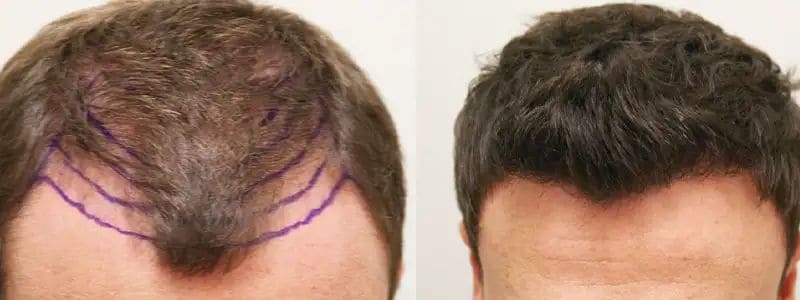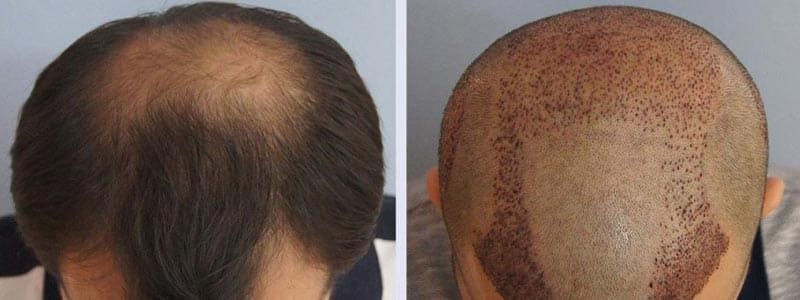Eyebrow Restoration Options
April 22, 2019

Hair transplant surgery is, undoubtedly, the most effective and the most popular hair restoration method. But it requires time and patience to achieve the desired results. However, expect your scalp to worsen initially while the transplanted hairs shed along with the existing healthy hair. It usually takes 12 to 18 months for a hair transplant surgery to manifest noticeable results. And during this time, the key is patience. But there is one thing we can do to speed up the results. We can use Rogaine after hair transplant surgery. According to evidence, Minoxidil (brand name Rogaine) has shown remarkable results when used after a hair transplant.
Below, we have shared different reasons for using Rogaine after hair transplant surgery. We have also shared information about when to use Minoxidil and whether it’s mandatory or not.
Hair transplant surgeons recommend their patients to use Minoxidil or Rogaine after a hair transplant. There are different reasons behind this recommendation that are backed up by evidence. Some of these reasons are mentioned below:
Hair transplant surgeons use specific ways to speed up the post-transplant recovery process and quicken hair growth. Some surgeons recommend their patients Minoxidil (3% and 5%) as part of the post-surgery protocol. They believe that it helps the transplanted hairs grow faster. A few studies have been conducted to support this claim. According to these studies, Minoxidil can help the hair grow more quickly, but it is not mandatory. More studies are required to prove Minoxidil’s efficacy after hair transplants.
Surgeons also recommend Minoxidil to patients because it can reduce the chance of shock loss, especially in women. Shock loss refers to the shedding of non-transplanted hairs after a transplant. It can be permanent or temporary, but, in most cases, hair regrowth occurs after a shock loss. With the help of Minoxidil, patients can skip the entire episode of shock loss.
A hair transplant surgery allows a person to restore a thicker head of hair. However, it does not control hair loss that may occur in the future. If you get a hair transplant at a young age, i.e., before 35, your hair loss will most likely progress after the surgery. In this case, you will require some oral or topical medications to control hair loss progression.
Surgeons typically recommend their patients to use topical Minoxidil for this purpose. However, hair loss medicines offer a temporary solution. It means the retained hair will begin to fall out as soon as the treatment stops. So, you will have to use Minoxidil for the rest of your life to avoid post-transplant hair loss.
When hair transplant surgeons prescribe Minoxidil to their patients, they also guide when to use Minoxidil after hair transplant.
Most surgeons recommend starting or continuing Minoxidil at least after a week or so of a hair transplant. It lets the transplanted hair settled into their new home before any external factor influences them.
Apart from this, another important decision is to figure out how long Minoxidil should be continued. If used to prevent the loss of existing hair, it has to be continued for a more extended period. However, it is only used to boost the transplanted hair growth; it shouldn’t be used for more than 4-6 months.
Minoxidil is not mandatory after a hair transplant. Some patients don’t need it, while others undergo a hair transplant to avoid using long-term medications. Minoxidil is only used as a complementary adjunctive therapy post-transplant. It means that using Minoxidil can yield results in 2-3 months that were otherwise expected to show after 4-6 months.
While Minoxidil can yield optimal results in the long term, not everyone feels that way. So, it must be discussed by the patient and surgeon beforehand. It will help the surgeon plan the entire surgery and post-surgery period accordingly.
Recently, a study was conducted that tested 12 hair transplant patients aged between 21 and 60 years. They were treated with a 3% Minoxidil solution following hair transplant surgery. Minoxidil therapy was started 48 to 72 hours after the surgery.
Typically, the shock loss phase occurs 2 to 4 weeks post-transplant. Two patients showed hair growth without shedding the transplanted grafts. Other patients also showed quick and healthy hair growth. Two of the remaining 10 patients experienced postsurgical telogen effluvium, but hair regrowth began within 4 weeks after shedding. Contrary to this, patients not treated with Minoxidil initially shed transplanted grafts. The hair growth also started 3 to 5 months after the surgery.
Based on the above study, we can conclude that topical Minoxidil is a useful adjunctive therapy during the recovery phase after hair transplants. However, carefully controlled studies are needed to support this claim.
If you seek the services of the best hair transplant surgeon in Dubai, contact Hair Transplant Dubai Clinic now. You can get the surgery done by one of our highly skilled surgeons. Moreover, you can earn a FREE Consultation session by filling the consultation form below.
Dr. Cagatay Sezgin is a celebrity hair transplant surgeon with over 20 years of experience in hair transplantation and restoration. He is the First Turkish Board Surgeon to become a member of the International Society of Hair Restoration Surgery (ISHRS) and the Asian Association of Hair Transplant Surgeons (AAHRS). Moreover, he has the honor of becoming the first hair transplant surgeon in the world to perform hair, eyebrow, and beard transplantation all in one case and that too in a single session.

April 22, 2019

July 27, 2014

August 8, 2016